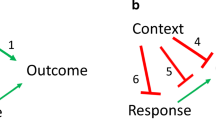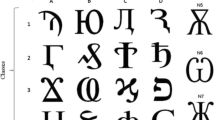Abstract
Male hooded rats were compared with non-estrus females in acquisition and extinction of an avoidance response. No differential extinction rates were found between these groups although terminal performance differences were present in acquisition. Females, which during acquisition were not in estrus, were divided into estrus and non-estrus groups in extinction. No differences were significant during early trials, but both performance and rate changes were noted thereafter, the non-estrus Ss being superior to estrus Ss on both measures. Results are discussed in terms of the influence of the estrus variable on male-female comparative studies.
Similar content being viewed by others
References
AREY, L. B. 1965. Developmental anatomy. Philadelphia: W. B. Sanders.
COREY, S. M. 1930. Sex differences in maze learning by white rats Journal of Comparative Psychology, 10, 333–339.
DENENBERG, V. H., & MORTON, J. R. C. 1964. Infantile stimulation, prepubertal sexual-social interaction, and emotionality Animal Behavior, 12, 11–13.
FINGER, F. W. 1969. Estrus and general activity in the rat Journal of Comparative and Physiological Psychology, 68, 461–466.
HUGHES, R. N. 1968. Behavior of male and female rats with free ’choice of two environments differing in novelty Animal Behavior, 16, 92–96.
MAYYASI, A. M., & TERRY, R. A. 1969. Effects of direct electric fields, noise, sex and age on maze learning in rats International Journal of Biometeorology, 13, 101–111.
RICHTER, C. P. 1922. A behavioristic study of the activity in rats Comparative Psychological Monographs, 1, 1–55.
STEWART, C. N., & BROOKSHIRE, K. H. 1967. Shuttle box avoidance learning and epinephrine Psychonomic Science, 9, 419–420.
TERRY, R. A., HARDEN, D. G., & MAYYASI, A. M. 1969. Effects of negative air ions, noise, sex and age on maze learning in rats International Journal of Biometeorology, 13, 39–49.
TOMILIN, M. I., & STONE, C. P. 1933. Sex difference in learning abilities of albino rats Journal of Comparative Psychology, 16, 207–229.
VALLE, F. P. 1970. Effects of strain, sex, and illumination on open-field behavior of rats The American Journal of Psychology, 83, 103–111.
WANG, G. H. 1923. The relation between “spontaneous” activity and oestrus cycle in the white rat Comparative Psychological Monographs, 2, 264–274.
Author information
Authors and Affiliations
Additional information
Portions of this research were supported by a universitv faculty grant made to R. C. Trost.
Rights and permissions
About this article
Cite this article
Ikard, W.L., Bennett, W.C., Lundin, R.W. et al. Acquisition and Extinction of the Conditioned Avoidance Response: a Comparison Between Male Rats and Estrus and Non-Estrus Female Rats. Psychol Rec 22, 249–254 (1972). https://doi.org/10.1007/BF03394088
Published:
Issue Date:
DOI: https://doi.org/10.1007/BF03394088




